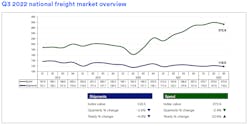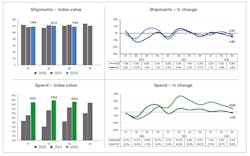Truck freight volume contracted and shipper spending dropped during the third quarter of this year as American households continued to adjust to inflation and shift their spending from goods to services, according to the most recent U.S. Bank Freight Payment Index.
The quarterly report from U.S. Bank pointed to higher prices for household necessities leaving less money for other products as one of the leading factors that curtailed truckload and less-than-truckload freight activity from July through September. Other factor impacting truck volumes was less home construction and imported and exported goods in Q3.
The third quarter saw the steepest drop in shipments since the start of 2021 as truck freight volumes fell 2.6% compared to Q2 this year. The U.S. Bank National Shipments Index showed Q3 volumes returning to Q1 levels after a 2.3% increase in Q2, according to the U.S. Bank data released on Oct. 19. But year-over-year volume is down 4.9%
“With inflation elevated, consumers are spending more on household staples at the expense of other products that are moved by freight truck,” according to Bob Costello, American Trucking Associations’ chief economist. “This transition—as well as weaker home construction activity—is impacting truck freight volumes.”
If it weren’t for a 5.8% Q3 uptick in freight in the Southwest U.S., the decline would have been more profound. The region’s freight volume is up 6.6% year-over-year, according to the index.
“High levels of oil production in the Southwest, as well as strong truck freight volumes with Mexico, helped avoid a much worse quarter for shipments,” Costello added.
Shippers spent less in Q3 2022
Along with reduced freight volumes across most of the U.S., contracted rates likely flattened from Q2, according to U.S. Bank.
Compared to Q2, shipper spending contracted by 2.4%, the second quarterly decrease on the U.S. Bank National Spend Index in the past two years.
The Southwest was the only region to see shipper spending increase (up 1.7% this quarter and 24.6% year-over-year). Shippers in the Midwest saw the most significant quarterly decline in spending (down 4% in Q3 and down 3.5% year-over-year). The Northeast also lagged behind national averages, seeing a 10.4% quarterly drop in volumes.
While Q3 2022 shipper spending fell compared to Q2, the numbers are still up 10.6% compared to Q3 2021. U.S. Bank analysts pointed to upward pressure on contract rates easing during the quarter. Third-quarter spending declines were attributed to falling diesel prices, lower fuel surcharges, lower shipment volumes, and stagnant rates, according to U.S. Bank analysts.
“Lower freight volumes—as well as dropping diesel prices in the quarter—led to the linked-quarter spending contraction,” according to Bobby Holland, U.S. Bank VP and director of freight data solutions. “Even with the third quarter dip, spending by shippers is still at near-record levels for the history of our index.”
2022 regional freight variances
The U.S. Bank Freight Payment Index measures quantitative changes in freight shipments and spending activity based on data from transactions processed through U.S. Bank Freight Payment. The business processed $37 billion in 2021 for some of the world's largest corporations and government agencies.
Here is how the shipments and spending broke down by region during Q3 2022, compared to Q2 (linked quarter) and this time in 2021 (year-over-year):
Midwest
The Midwest hasn't seen a year-over-year increase in shipment volume since Q1 2020. Slowing new home construction—down 15% from the same period last year, according to the U.S. Census Bureau—could be a factor in weaker truck freight volume, according to U.S. Bank.
Shipments
Linked quarter: -4%
Year over year: -3.5%
Spending
Linked quarter: -5.3%
Year over year: 6.5%
West
While shipments in the West contracted in Q3, the region had the second-best results behind the Southwest. Softer port activity in the West could have factored into the contraction, according to U.S. Bank. The drop in spending was only the second quarterly decrease in the last six quarters.
Shipments
Linked quarter: -0.4%
Year over year: -4.6%
Spending
Linked quarter: -0.8%
Year over year: 11.6%
Northeast
The 10.4% drop reversed a 7.3% Q2 increase in Northeast shipments. The 1.4% drop in spending—much less than the drop in shipments—suggests that capacity remains somewhat constrained in the Northeast.
Shipments
Linked quarter: -10.4%
Year over year: -7.1%
Spending
Linked quarter: -1.4%
Year over year: 11.9%
Southeast
This was the fifth straight quarter shipments contracted in the Southeast. Spending dropped, but at a lower percentage than the national figures.
Shipments
Linked quarter: -1.1
Year over year: -10.5%
Spending
Linked quarter: -0.1%
Year over year: 10.2%
Southwest
The Southwest had far higher increases in shipments and spending than other regions. Solid crude oil production, strong truck freight volumes with Mexico and increases in imports to the region helped increase volume and spending in the region.
Shipments
Linked quarter: 5.8%
Year over year: 6.6%
Spending
Third quarter: 1.7%
Year over year: 24.6%
About the Author
Josh Fisher
Editor-in-Chief
Editor-in-Chief Josh Fisher has been with FleetOwner since 2017. He covers everything from modern fleet management to operational efficiency, artificial intelligence, autonomous trucking, alternative fuels and powertrains, regulations, and emerging transportation technology. Based in Maryland, he writes the Lane Shift Ahead column about the changing North American transportation landscape.




